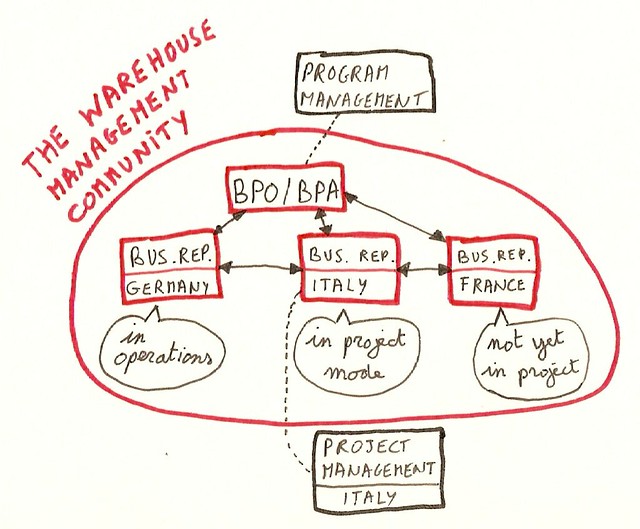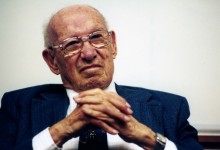A bold prediction for 2013: social media is here to stay and it will improve the way you manage projects.
Even when the dust is settling over the 2012 social media hype we are finding that its value goes way beyond annoying marketing techniques and IPO’s. Here is my prediction for 2013: social media is a project accelerator – and a major one.
=> What I am talking about is untapped potential (as opposed to extra work/budget on top of what is on your shoulders)
=> What you should be looking for is the leverage of 3 effects
The Ripple Effect
So much of what we call management consists in making it difficult for people to work.
(Peter Drucker)
The ripple effect is about people being on the same wavelength when they are faced with the same challenge. In an earlier article I talked about the community of warehouse managers. When rolling out a warehouse management system across all the plants of a multinational company there is only a limited amount of time for the project experts to engage in trouble-shooting.

On the other hand, the people in the field who are going to be the new owners of this system are always forgotten because they are labeled as ‘resistant’ even before we start the deployment. As a result of OUR limited mindset we don’t even engage into further activities with the community of warehouse managers. That’s a big mistake, because as a result of our twisted mindset they will conform to the context we have created: they will start behaving as victims.
We need to be honest to ourselves and stop creating contexts for victims. Instead, we can allow the Ripple Effect: create a social architecture for these warehouse managers, so they can take responsibility for what they share and take away from their community.
Just remember: the Ripple Effect has always existed – we just need to stop blocking it with our closed mindsets.
The Storytelling Effect
In his brilliant 2000 article Growing Up Digital, John Seely Brown describes the anthropological study he conducted at Xerox in order to find out how technicians solve problems. A team of anthropologists observed the technicians as they intervened to repair photocopiers. Seely Brown recalls being totally surprised by the results of the anthropological research as he explained:
So troubleshooting is really story construction, not abstract logical reasoning. They didn’t even talk about partial differential equations, which was a shock to me. These guys were storytelling, taking fragments of past stories that they knew or had experienced, weaving them together with new fragments until they had “explained” the machine’s behavior.
Now, what do they do with these stories? When they come back to the home office, they sit around playing cribbage, drinking coffee, swapping war stories. Amazing amounts of learning were happening in the telling of and listening to these war stories. In telling a story, the story gets refined. In listening to the story, fragments of past stories get reorganized and refined and so on and so forth. Learning was happening in a fantastic way in terms of telling and listening to stories.
What he observed can be summarized in two main conclusions:
- The ‘tribe’ of technicians never used any manual or handbook to solve a problem with a photocopier. Instead, they called other technicians to share their observations in order to compare them to other problems they had run into before;
- The knowledge that was needed to solve a problem was produced on the spot as the result of a co-creation of insights and experiences of other technicians. And when the problem was solved, this tribe gathered around a table to drink coffee and replay the whole story. That is how the new knowledge got stored into the brain of the community.
The moral of the story? The community IS the knowledge and its health is determined by the relationships and connections. From now on, let’s tolerate formal training and fully support storytelling and sharing, instead of the other way around.
The Matthew Effect
For to all those who have, more will be given, and they will have an abundance; but from those who have nothing, even what they have will be taken away.
—Matthew 25:29
In an earlier post I have explored the logic of commitment and found that every commitment – how small and insignificant it may seem – makes the next commitment possible. This makes perfect sense and tells us a great deal about how we need to organize in order to reach the highest level of commitment.
Now here is the catch: the way you build a social architecture around the project strengthens the community. As controversial as it may seem: the more you ask of the members of your community early on, the more they tend to become engaged.
Most of the times we feel embarrassed and don’t want to increase the burden on their shoulders. But that’s just flat wrong! We should focus on chopping the work into meaningful bits that they can commit to. And by doing so they are further strengthening the fabric of the community (provided that we are not blocking the Ripple Effect).
It sounds too simple to be true: at first you ask people to join, then to post their profile picture, next to vote on a survey, later to post their opinion on a minor change,… and before your know it they are helping each other and sharing their lessons learned.
Got it?
Now go and eat that Christmas turkey, because in 2013 amazing things are about to happen…



